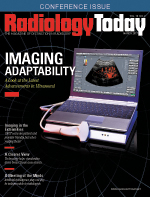 March 2017
March 2017
Editor's Note: What Does Efficiency Look Like?
By Dave Yeager
Radiology Today
Vol. 18 No. 3 P. 6
Doing things better in less time has become the mantra of health care. Particularly in medical imaging, getting the best image in the least amount of time, the first time, is paramount. Reading those images accurately and quickly is also essential. In this month's issue, we're taking a look at different facets of efficiency with articles about technologies that are—or soon will be—improving image acquisition, interpretation, and workflow.
Our cover story by Keith Loria surveys ultrasound manufacturers to learn about recent trends. Because it doesn't produce ionizing radiation and can be used in a wide variety of clinical settings, ultrasound has never been more popular. As the devices become more compact and reach new levels of image quality, expect them to proliferate further.
Another type of imaging that's gaining traction (pun intended) is cone beam CT for extremity imaging. The systems provide high-quality images at significantly lower radiation doses—and lower cost—than conventional CT, and they allow physicians to get a look at bones while they are bearing weight, something that's not possible with conventional CT. Many orthopedic offices are buying CBCT machines but, as Beth Orenstein reports, there is some question about whether orthopedists will be tempted to read the scans themselves.
Processing software can also affect efficiency. For example, dense breast tissue often obscures nodules, and determining what constitutes dense tissue is still largely a subjective exercise. Kathy Hardy's article about processing software for mammograms looks at some of the companies that are attempting to improve the visualization and quantification of dense breast tissue to help radiologists find breast cancers.
Finally, Sandra Nunn explores the potential of the technology that has caused the most hand wringing and gnashing of teeth in radiology over the past year or so—artificial intelligence. Although AI may one day completely replace radiologists—say in about 50 or 100 years—the nearer term looks far more promising for radiologists and their patients. According to Nunn's sources, the most likely scenario is that radiologists will soon be using AI tools to improve diagnosis and workflow in a way that neither humans nor machines can achieve alone.
Enjoy the issue.
david.yeager@gvpub.com
